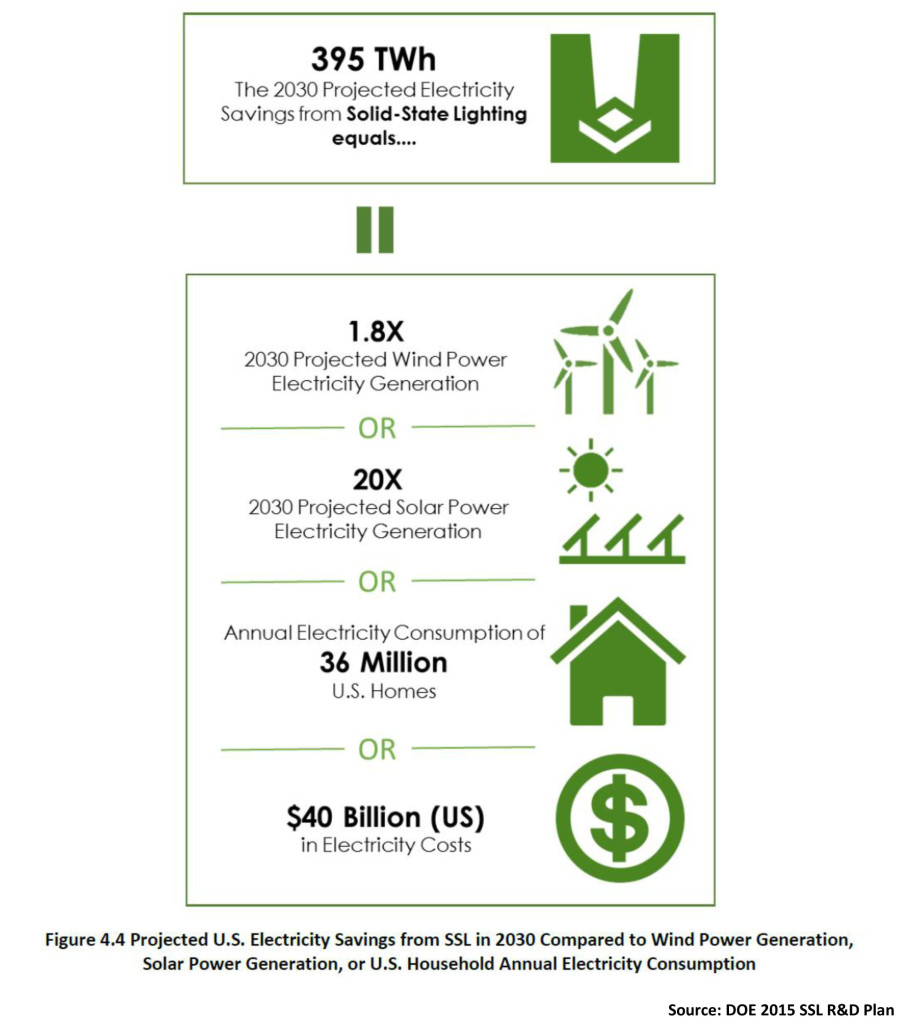What is the difference between LEDs and residential solar panels? Plenty, clearly, but for a utility executive worried about slow or no load growth they amount to exactly the same thing—trouble.
I have written extensively about the broad utility-led campaign to quash state net metering programs (see these posts here and here). In general, this effort is based on the premise that net metering unfairly benefits residential solar users (by overpaying them for their generation) and shifts costs onto non-solar customers (by forcing companies to charge them for the fixed costs no longer being paid for by the solar customers through their electricity purchases). But that premise is also true of LEDs if you think it through.
This week I decided to replace a bank of six aging incandescent lightbulbs in my home’s master bathroom with new LEDs—something homeowners are doing with increasing frequency around the country. In years past, this would have been a non-event, but with LEDs’ vastly improved efficiency and lengthy lifespan the equation has changed significantly.
I did a little back of the envelope calculating about the switch: The six bulbs I pulled out consumed 260 watts of electricity when turned on (for reasons unclear to me I had five 40W bulbs and one 60W bulb installed in the bathroom), the new ones just 66W total (and they are brighter to boot, but that is another story). So, every time I turn on the bathroom light switch I am saving 194 watts. That’s an admittedly small amount of power, but if you figure the lights are on for three hours daily that adds up to 582 watt-hours per day. That’s still not much, but over the course of a month, these six lights could save me on the order of 17.5 kilowatt-hours (30×582=17,460 watt-hours or 17.46 kwh).
While that may not sound like a lot, my total consumption last month (my bill was dated June 25 before the summer heat settled in and the AC started running non-stop) amounted to 874 kwh. In other words, those six inefficient incandescent may have accounted for as much as 2 percent of my overall consumption. But no more, that consumption is gone, and given the new lights 20 year expected lifespan, effectively never to return.
And even if you take a longer view of my home’s consumption—say the past six months, or all of 2014 (which I did, and found a surprisingly consistent monthly average of 1080 kwh for both periods)—those six lights still accounted for more than 1.5 percent of my electric consumption.
Monetarily, it’s a tiny loss for Dominion (my local utility) given that my rates range from 3.795 cents per kwh for the first 800 kwh I consume to a maximum of 5.773 cents per kwh during the peak summer season (with conversely lower rates above 800 kwh of consumption during the winter months), and a correspondingly small monthly benefit for me. But here’s the rub, and it’s exactly the same criticism leveled by the utility industry against net metered residential solar customers: I am now no longer buying those 17.5 kwh a month—and the small amount of fixed system charges that I had previously been paying for through that consumption I am now essentially shifting to other users.
If I was the only customer installing LEDs, this wouldn’t be an issue, but when thousands of consumers do exactly the same thing it adds up. The problem for Dominion and other utilities is that thousands of consumers are doing exactly what I just did, and many thousands (if not millions) are expected to do the same thing in the years to come. For example, a DOE report issued last year (which can be found here) estimated that upward of one-third of all residential lighting sales would be LEDs by 2020, up from less than 1 percent in 2013.
Clearly, new rate structures that don’t rely on recovering fixed system charges through monthly sales are needed because criticizing ratepayers (oh, that’s right, utilities like to call us customers now) for investing their own funds to cut their electricity consumption is a losing proposition for the utility industry.
Now it’s time to figure out which of my remaining old-school lightbulbs to replace next—before Dominion tries to make me pay for not covering my “fair” share of the utility’s fixed costs.
–Dennis Wamsted

 Follow
Follow
Dennis, I have thought it through, and you’re wrong.
Net metering compensates owners of solar panels at retail rates for the energy they contribute to the grid – more than utilities pay any other provider. That results in more than unsold energy: it’s an actual cost to the utility, and money they can’t use to maintain infrastructure and keep the lights on for everyone. Who makes up the difference? Customers without solar panels (yes, you are a “customer” – like everyone else, you’re not entitled to free energy).
In my opinion, Dominion should charge an “entitlement” fee, like what’s happening in Spain, for the convenience of connecting to the grid without contributing one’s fair share (as well as the convenience of whining about it).